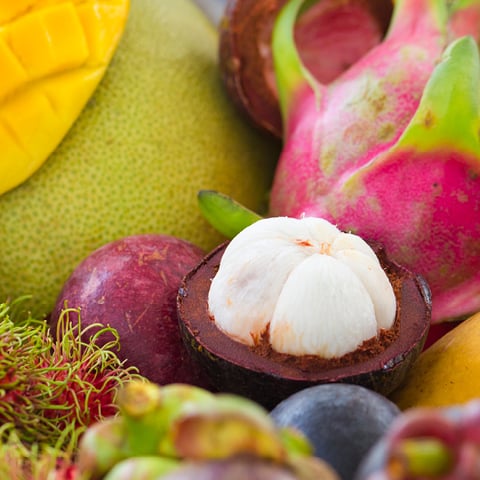言語を選択
通貨を選択

南国の果物に関する基礎知識
象徴的なパイナップルを超えて、ハワイの農家は色とりどりのエキゾチックなトロピカル フルーツを栽培しています。マンゴー、パパイヤ、グァバ、パンノキ、ココナツ、アボカド、バナナ、ベリー類はすべて地元のファーマーズ マーケットやスーパーマーケットで簡単に見つけることができます。これらのトロピカル フルーツのいくつかは、グラムの最も美しいスナップ、 彼らもまたおいしい.
では、これらの果物にはどのようなものがあり、どのような味がするのでしょうか?これは、より人気のある果物のいくつかのアルファベット順のサンプルです.
アビウ(ポウテリア・カイミト): 黄色い、野球サイズの果物はアマゾンから来て、皮をむく必要があるグミのラテックスの外面を持っています.その透明な果肉は、キャラメルのヒントやメロンと柿のジェルブレンドのバニラプディングのような味と表現されています.
パンノキ(アルトカルプス・アルティリス):
桑科の花木であるパンノキは、太平洋のほとんどの地域で生育します。
島であり、食事のデンプン成分の代わりになることがあります。調理すると、'ulu、ハワイ語でパンノキ、ポテトのような風味がします。グリル、ボイル、ロースト、ベイクドと用途の広いフルーツ
または揚げた。
カイミト(クリソフィラム・カイニート):
一般にスター アップルとして知られるこの果物は、大アンティル諸島と西インド諸島原産です。芯を横に切ると星のような形になることからこの名が付きました。そのフレーバー プロファイルは、カスタードとリンゴのクロスです。
ドラゴンフルーツ(ヒロセレウス):
ナシとキウイのハイブリッドのような味わいのドラゴン フルーツまたはピタヤは、サボテンの一種であり、
白、赤、マゼンタの三原色があります。成熟度を判断するには、しみがほとんどなく明るく均一な色の皮を探します。
ドリアン(デュリオ・ジベティヌス):
東南アジアでは果物の王様と認識されているかもしれませんが、西洋人は通常、その刺激的な香りや「臭い足」の臭いを逃れることができません.有名なナチュラリストのアルフレッド・ラッセル・ウォレスは、その果肉を「アーモンドで風味豊かな濃厚なカスタード」と表現しました。
ジャックフルーツ( Artocarpus ヘテロフィルス):
平均体重20に40ポンド、ジャックフルーツは東インド諸島から来ています。ジューシーフルーツガムのような味がすると言う人もいれば、バナナとパパイヤのクロスだと考える人もいます.そのバターのような果肉は繊維が密集しており、しばしばでんぷん質と表現されます。
ランサット(ランシウム・ドメスティウム):
これらの小さな黄色の球形の果物は房状に成長し、熟していないときはかなり酸っぱいことがありますが、熟すとブドウとオレンジのヒントがあり、完全に甘くなります.
リリコイ(トケイソウ):
パッションフルーツの植物は壮観な1- に3黄色または紫色の果実を持つ 1 インチの花。紫色の品種の種子は、マウイ島で最初に植えられました。 1880ユージーン・デレマーがオーストラリアから持ってきて、今でも「リリコイ ガルチ」として知られる地域の牧場に植えました。さまざまなフレーバー プロファイルには、マンゴーとレモンの風味、パパイヤとパイナップルのミックスなどがあります。
マンゴスチン(ガルシニアマンゴスターナ):
原産地はインドネシアのスンダ諸島とモルッカ諸島であると考えられているパープル マンゴスチンの香り高く食用に適する果肉は、甘くて酸味があり、柑橘系でピーチです。硬い殻をナイフで割って割って開ける必要があります。
ランブータン(ネフェリウム・ラパセウム):
ライチやリュウガンと同様に、ランブータンは柔らかいトゲで覆われています。マレー諸島原産のこの果物の名前は、「毛むくじゃら」を意味するマレー語に由来しており、その理由がわかります。しかし、毛むくじゃらの皮をむくと、ブドウのような甘みと酸味のバランスがとれた、柔らかくて肉厚な果実になります。
ホワイトサポテ(カシミロア・エドゥリス):
メキシコ原産の白いサポテは、バナナのような桃から梨、バニラ フランまでさまざまな風味があります。グラニースミス アップルに似た滑らかな果肉の食感から、「カスタード アップル」と呼ばれることもあります。
アビウであろうとホワイトサポテであろうと、ハワイの果物を試食したくなるでしょう。しかし、これらの甘い果物を味わった後は、家に帰りたくないかもしれません.